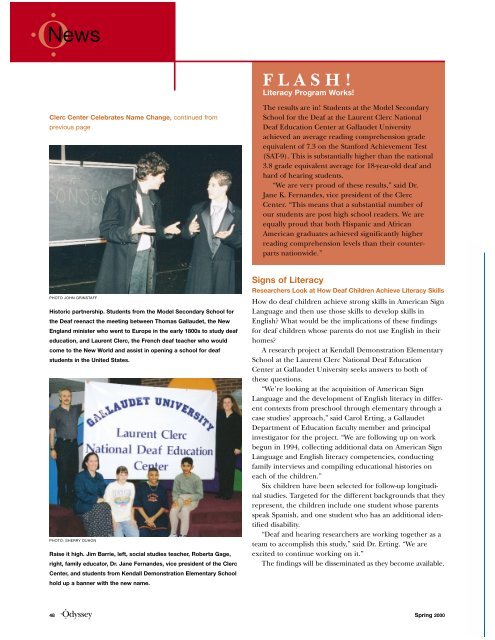Deaf ESL Students - Gallaudet University
Deaf ESL Students - Gallaudet University
Deaf ESL Students - Gallaudet University
You also want an ePaper? Increase the reach of your titles
YUMPU automatically turns print PDFs into web optimized ePapers that Google loves.
O News<br />
Clerc Center Celebrates Name Change, continued from<br />
previous page<br />
PHOTO JOHN GRINSTAFF<br />
Historic partnership. <strong>Students</strong> from the Model Secondary School for<br />
the <strong>Deaf</strong> reenact the meeting between Thomas <strong>Gallaudet</strong>, the New<br />
England minister who went to Europe in the early 1800s to study deaf<br />
education, and Laurent Clerc, the French deaf teacher who would<br />
come to the New World and assist in opening a school for deaf<br />
students in the United States.<br />
PHOTO: SHERRY DUHON<br />
Raise it high. Jim Barrie, left, social studies teacher, Roberta Gage,<br />
right, family educator, Dr. Jane Fernandes, vice president of the Clerc<br />
Center, and students from Kendall Demonstration Elementary School<br />
hold up a banner with the new name.<br />
F L A S H !<br />
Literacy Program Works!<br />
The results are in! <strong>Students</strong> at the Model Secondary<br />
School for the <strong>Deaf</strong> at the Laurent Clerc National<br />
<strong>Deaf</strong> Education Center at <strong>Gallaudet</strong> <strong>University</strong><br />
achieved an average reading comprehension grade<br />
equivalent of 7.3 on the Stanford Achievement Test<br />
(SAT-9). This is substantially higher than the national<br />
3.8 grade equivalent average for 18-year-old deaf and<br />
hard of hearing students.<br />
“We are very proud of these results,” said Dr.<br />
Jane K. Fernandes, vice president of the Clerc<br />
Center. “This means that a substantial number of<br />
our students are post high school readers. We are<br />
equally proud that both Hispanic and African<br />
American graduates achieved significantly higher<br />
reading comprehension levels than their counterparts<br />
nationwide.”<br />
Signs of Literacy<br />
Researchers Look at How <strong>Deaf</strong> Children Achieve Literacy Skills<br />
How do deaf children achieve strong skills in American Sign<br />
Language and then use those skills to develop skills in<br />
English? What would be the implications of these findings<br />
for deaf children whose parents do not use English in their<br />
homes?<br />
A research project at Kendall Demonstration Elementary<br />
School at the Laurent Clerc National <strong>Deaf</strong> Education<br />
Center at <strong>Gallaudet</strong> <strong>University</strong> seeks answers to both of<br />
these questions.<br />
“We’re looking at the acquisition of American Sign<br />
Language and the development of English literacy in different<br />
contexts from preschool through elementary through a<br />
case studies’ approach,” said Carol Erting, a <strong>Gallaudet</strong><br />
Department of Education faculty member and principal<br />
investigator for the project. “We are following up on work<br />
begun in 1994, collecting additional data on American Sign<br />
Language and English literacy competencies, conducting<br />
family interviews and compiling educational histories on<br />
each of the children.”<br />
Six children have been selected for follow-up longitudinal<br />
studies. Targeted for the different backgrounds that they<br />
represent, the children include one student whose parents<br />
speak Spanish, and one student who has an additional identified<br />
disability.<br />
“<strong>Deaf</strong> and hearing researchers are working together as a<br />
team to accomplish this study,” said Dr. Erting. “We are<br />
excited to continue working on it.”<br />
The findings will be disseminated as they become available.<br />
48 Spring 2000
















